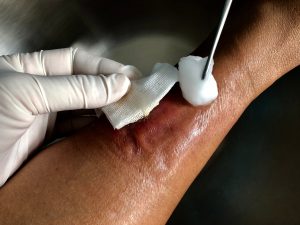Localised vancomycin delivery via microneedle arrays reduces methicillin-resistant Staphylococcus aureus growth on skin

Skin and soft-tissue infections (SSTI) are a common type of bacterial infection, making up almost 10% of annual hospitalisations.1 Staphylococcus aureus is the causative agent in most cases of SSTIs, and a rise in the incidence of these infections has been associated with increasing antimicrobial resistance and the emergence of methicillin-resistant S. aureus (MRSA).2 SSTIs present in a range of severities from simple cellulitis to progressively life-threatening infections such as necrotising fasciitis.1
Vancomycin is an antibiotic commonly used for the treatment of MRSA infections. Treatment usually involves intravenous (IV) delivery of the antibiotic due to poor gastro-intestinal absorption when delivered orally, and its large molecule size that cannot pass the dermal barrier when administered topically.2 However, IV delivery is often associated with systemic exposure and resultant side effects such as pain, thrombophlebitis, and kidney damage.2
Some studies have explored methods to increase vancomycin concentration at target sites and reduce side effects.3,4 However, these methods involve IV or intradermal injections, which are associated with the aforementioned side effects, and trained personnel are required to administer treatment. To address these challenges, Ziesmer et al. explored microneedle (MN) applications, which have previously showed effectivity in transdermal drug delivery, including vancomycin, but had yet to be tested on MRSA SSTIs. The researchers developed vancomycin-MN arrays equipped with a water-insoluble support layer, which allowed for high drug encapsulation and dosage control.2 When applied, the water-soluble drug-loaded needle tips embed into the skin and the support layer protects the drug from diffusing out of the target site.
The key findings from their research are as follows2:
- The vancomycin-MN arrays were able to penetrate dermal barriers in both porcine and fresh human skin.
- Vancomycin delivered was mostly retained within the skin.
- There was a reduction in MRSA growth by the vancomycin-MN arrays both in vitro (as tested by agar-diffusion) and on ex vivo skin.
Evidence suggests that local, topical administration of vancomycin could reduce side effects as there is a decreased risk of systemic absorption compared to IV or oral administration routes.5 Systemic absorption rates of IV or oral antibiotics, while generally low, can be unpredictable among patients with impaired renal function, or those who undergo prolonged administration of high-dose antibiotics during treatment.6
Local drug administration methods such as the vancomycin-MN arrays developed by Ziesmer et al. could be especially beneficial in the treatment of SSTIs in these patient groups. The arrays could also be extended to other drugs that have previously shown reduced skin-permeability. This would greatly facilitate the treatment of MRSA SSTIs and reduce side effects that arise from systemic absorption of antibiotics.
References
- Abhilash KP, Varghese S. Curr Med Issues 2019;17:30-33
- Ziesmer J, et al. Advanced Material Tech 2021;6:2001307
- Mohammed MI, et al. Int J Pharm Pharm Sci 2014;6:190-194.
- Yousry C, et al. Drug Dev Ind Pharm 2016;42:1752-1762
- Socco S. Is there information on intrawound/topical vancomycin powder in craniotomy? Available at: https://dig.pharmacy.uic.edu/faqs/2020-2/december-2020-faqs/is-there-information-on-intrawound-topical-vancomycin-powder-in-craniotomy/. Accessed 2 November 2021.
- Coutsouvelis J, et al. J Pharm Pract Res 2011;41:225-226.










